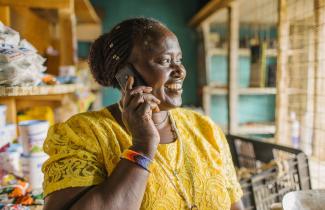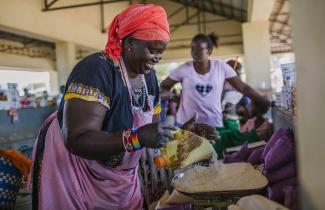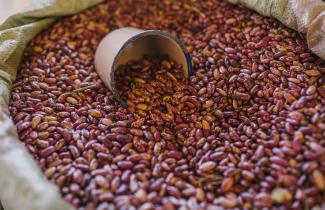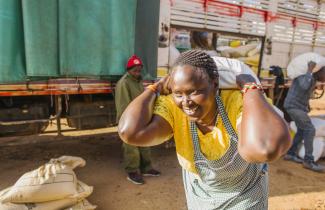A Place to Trade
Stronger markets empower women in Kenya’s drylands
Photos by Bobby Neptune for USAID
March 2020

Veronica Nalari Lengirnas likes to tell the story of Oldonyiro market in northern Kenya. After all, she’s been running her business here for over 20 years.
We used to sell our goods, scorching under the sun,” she says. “Now we are under the shade, happy.”
When Veronica started as a trader, she sold just one bag of flour each week. Today, Veronica is one of the busiest traders in the market. She sells flour, maize, sugar, and beans.



From Survive to Thrive
Here, recurring droughts and conflicts set families back, making it difficult to escape poverty. Women often bear the brunt of these hardships. However, stronger markets can help families bounce back from a crisis.
In 2015, USAID partnered with the Government of Kenya to revitalize Oldonyiro market, attracting traders with better security, health and business services, a drought warning system, and a roof providing shade.


The community transformed with the market. Today, Oldonyiro is a bustling marketplace, with traders selling every Tuesday.
Even during drought, the market stays open. Families can sell their livestock and earn cash to stay afloat. They can now buy more nutritious food, too.



Overcoming Barriers
Nevertheless, Veronica and her fellow women traders faced unique challenges to growing their businesses in this male-dominated marketplace. “We would sell on the sidelines of the market,” she says.
Through Feed the Future, the U.S. Government's global hunger and food security initiative, USAID helped women like Veronica overcome these barriers.


With a safe and reliable place to trade, more women like Veronica can grow their businesses.
Veronica got a $300 loan to expand her business, and paid it back after five months. She used the profit from her business to buy a car to deliver more goods to the market and boost her income.

Veronica helped start a savings group with other women to pool their money to start businesses and better provide for their families, especially in times of need.
“That is why the market has many women [now],” says Veronica. “They are trying to improve their children's lives.”



With her income, Veronica is sending her four children to school and feeding them nutritious food. “I love my business. With that job, I’ve brought up my children.”



Veronica wants to continue building her business so she can employ others. With USAID’s help, women like Veronica are connecting to growing markets in drought-prone northern Kenya. They are leaders in breaking the cycles of poverty, hunger, and malnutrition that have gripped these areas for decades.
About This Story
When women can grow their businesses and income, they build healthier families and stronger communities. After a devastating drought in 2011, USAID worked in partnership with the Government of Kenya to get ahead of drought through the government-led Ending Drought Emergencies initiative.
USAID’s Partnership for Resilience and Economic Growth brings together humanitarian and development partners to strengthen resilience in these vulnerable pastoralist communities in northern Kenya.
Not only are these communities transforming and becoming more resilient, but so are the women who are the drivers and backbone of progress against poverty, hunger, and malnutrition.
Through Feed the Future, USAID has rehabilitated 20 livestock markets in northern Kenya, helping nearly 80,000 families strengthen resilience to recurring crises and reducing the need for humanitarian assistance.
In 2014, these programs provided over 10,000 survivors of sexual violence with support and counseling, and more than 22,000 with economic assistance.
The work is implemented by International Medical Corps with the American Bar Association and Cooperazione Internazionale; and by Interchurch Medical Assistance Inc. with Heal Africa, Panzi Hospital, and Program for the Promotion of Primary Health Care.


